Business cards originated in China in the fifteenth century. Back then, they were known as “meishi.” Today they are perhaps the most freely distributed commodity in the business world, as well as an essential part of your DIY marketing toolkit. But business cards can’t help you network if you don’t use them wisely. This post will give you 4 tips on business card etiquette so you can get the most mileage out of each card.
Related: 30 creative business card ideas & designs to help yours stand out
1. Perfect your business card design
To be a true master of business card technique, you must first have a standout business card. Your card is you at a glance, and you want that first impression to be positive and clear. In essence, you’re creating a personal brand that speaks to people, just as you would. Look at others’ business cards to get inspiration, and learn how to create your own personal logo. Then, use Lucidpress to create your own from scratch or from one of our free business card templates.
We can learn one business card lesson from nineteenth-century England. At that time, business cards were referred to as “trade cards,” and they featured a map intended to direct potential customers to the cardholder’s business. Your business cards should do the same thing: get potential customers in touch with you ASAP.
Make sure you put the most important information front and center in a font that stands out. You can also creatively use color to your advantage, keeping in mind that different colors have different psychological effects.
When it comes to business cards, the possibilities are nearly endless. You can put shiny lettering and inventive textures, or forge your business card out of pure platinum and install a tiny speaker that announces your name and title when your card senses the touch of fingerprints. Hey, one can dream.
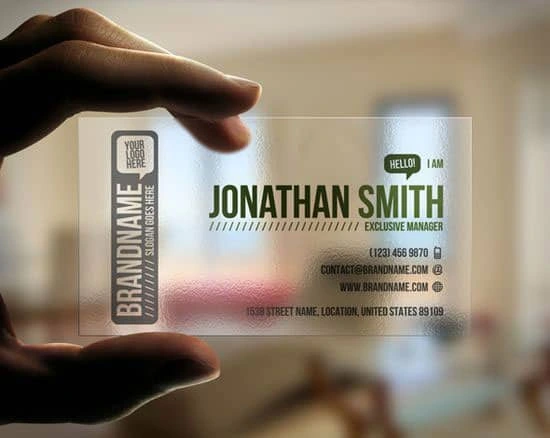
Photo from Overflow Graphics
All right, the last option is a little out there, but there’s no doubt that you have a lot of options. If you design your business card with Lucidpress, you can even add a photo and a QR code. All of this can help people remember you and increase your chances of hearing from them.
As a final note on design, don’t forget to give serious thought to the material you use. Perhaps you’ve fought the losing battle of trying to write on a glossy card that deflects ink like it’s the plague. A poor paper choice can throw off your whole business card mojo. After designing your card in Lucidpress, you can take your design to your favorite printing shop or order prints directly from us. These days, your business card can even be edible. Whether or not you choose to go this route, your design should be so sumptuous that people have to restrain themselves from taking a bite.

Photo from Meat Cards
2. Don’t abuse the power of the card
A well-designed, well-placed business card can be an invaluable tool. But like money, business cards can suffer from inflation: if you give too many of them out, their value will go down. On the other hand, a thoughtful approach preserves the strength of the business card as an ace networking and marketing tool.
If someone walks up to you, smiles and hands you their business card, that card probably won’t be remembered for long, even if the person who gave it to you had a really nice smile. The truth is that, without some sort of a connection made before the exchanging of cards, both parties will soon forget about the whole thing. Humans are social beings, and a business card is powerful because it is a representation of an actual person you can see and talk with.
So what happens if you abuse the power of the card? Well, not to get all doom-and-gloom, but negative side effects may include a cheapening of your professional image, irrelevant emails and phone calls that waste everyone’s time, and loss of credibility.
3. Observe business etiquette
It’s also important to respect others’ cards. It’s a good idea to avoid writing on a card in front of the giver unless it’s related to a request they made (or something similar). Use your best judgement.
The point is that you never want someone to feel used, so instead of writing down how someone can help you, chat about how you can help them. The way you store your card and the cards that are given to you will be a reflection of your professionalism and respect. You spent a lot of time deciding on a card that presents you in a positive way, and most everyone else has thought a lot about that, too. So give your cards some love by keeping them in a case.
When someone gives you one of their business cards, take some time to look it over, then find somewhere to put it that communicates respect to the giver. [![]() ] A card case will work perfectly, and if that’s not an option, your best bet is to either hold onto the card until the conversation is over or thoughtfully place the card in your suit pocket or purse. Business etiquette goes a long way.
] A card case will work perfectly, and if that’s not an option, your best bet is to either hold onto the card until the conversation is over or thoughtfully place the card in your suit pocket or purse. Business etiquette goes a long way.
4. Consider the culture
Business card customs are fairly informal in the United States, but there are specific rules and norms in other countries that are important to observe. For example, if you are doing business in Japan, you should know that business cards are seen as an extension of the individual to which they belong.
Also, be sure to not shake hands when exchanging business cards in Japan. A small bow is the way to go, and it’s best to present your business card with both hands. When doing any kind of international business, take some time to familiarize yourself with the customs of the country you’ll be working in. A little research can help you save face down the road.
Now you’re ready to conquer the business world with your finely-tuned business card savvy.
You’ve got this! If you liked what you learned today, feel free to share this handy infographic.
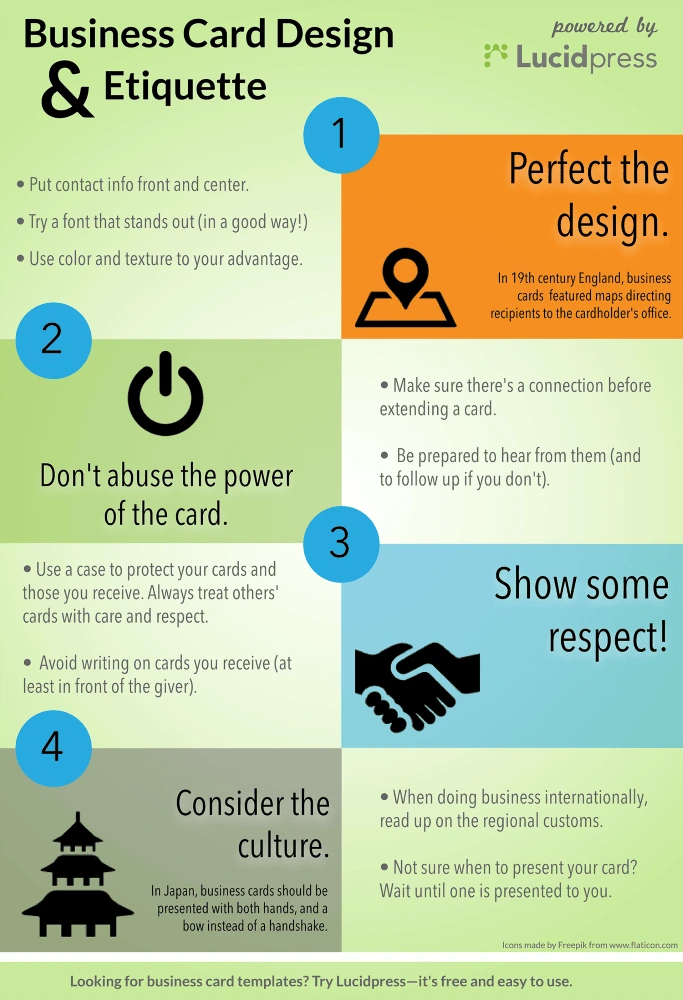
And of course, don’t forget about our free business card templates!
So. It’s almost October 31st, and you don’t have a Halloween costume idea yet. The situation is even more dire if you’re facing a company costume contest. Your competitive side yearns to get decked out as a steampunk zombie Stormtrooper, but do you really have time for all that? Better just watch Hocus Pocus for the umpteenth time and let Glen from sales get all the glory…
Or not! In the immortal words of Edna Mode, pull yourself together. Here are 10 of our best last-minute group costume ideas. All of them are appropriate for work, and most can be adjusted if you’re dressing up solo. Plus, if you’re a business owner, celebrating holidays can go hand-in-hand with seasonal marketing goals like increasing your presence in the community. Let’s get spooky!
Related: How to make free party invitations
1. Quoth the raven, “Nevermore”
Why not dress up as a group of literary characters? Here we have Edgar Allen Poe, the Raven and Annabel Lee. But don’t forget about characters from The Legend of Sleepy Hollow, The Scarlet Letter, Strange Case of Dr. Jekyll and Mr. Hyde, The Shining, Rip Van Winkle, and more. The more recognizable the story, the better. If you’ve got a large group, try dressing up the extras as townspeople or peripheral characters.
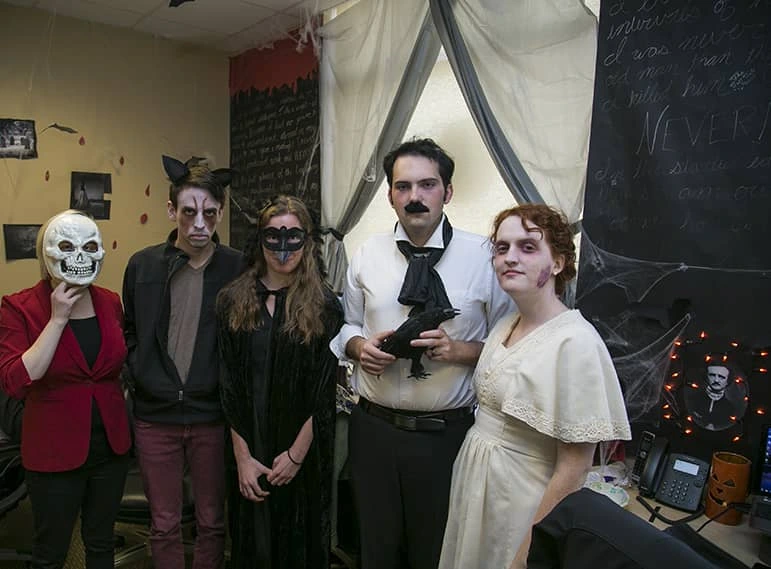
2. Zombies anonymous
The zombie craze started several years ago, so dressing up as a zombie may feel played out. That’s why you should be a reformed zombie. Slap on some zombie makeup, but keep your clothes business casual, and don’t forget a name tag on your shirt. Bonus points if your group switches their seating arrangement to a circle of folding chairs.

Photo credit: Steve Spezz
3. Pun for cover
No one will be safe from your cunning punnery. You can put a twist on popular songs, as Demi Lovato did with “Trap Queen” by rapper Fetty Wap. Or come up with creative takes on common phrases. For example, this year I’m dressing up as a fox and carrying around a Coldstone Creamery cup (get it?). My husband will wear a baggy shirt tucked into high-waisted jeans and carry a fryer basket from the local thrift shop. That’s right—he’s Friar Tuck. I can hear the groans already!

Photo credit: Dimitrios Kambouris/MTV
4. Famous ghosts
What could be easier than a ghost costume? To add some flair to this idea, have each member of your group go as a famous ghost. There’s Nearly Headless Nick, Casper, The Ghost of Christmas Past, and even Slimer from Ghostbusters. Just take your pick!

Photo credit: greyloch
5. Video vixens & villains
Get inspired by music videos like Taylor Swift’s “Bad Blood.” Your girl gang just needs to dress in black, add some metallic flourishes, (what else is duct tape for if not last-minute costumes?), and stomp through the office like aspiring models. You can also dress up like rock stars (The Misfits, New York Dolls), boyband members (Backstreet Boys, One Direction), riot grrrls (Bikini Kill, Sleater-Kinney)… the possibilities are endless.

Photo credit: YouTube
6. The creative force awakens
Stay ahead of the curve by dressing up as characters from popular movies like Star Wars: The Force Awakens. The teaser trailers usually have plenty of material to work with. Other easy-to-riff movies & TV shows include The Royal Tenenbaums, Empire, Scooby Doo, Office Space, Star Trek, The Addams Family, and a whole lot more. Again, the more recognizable the source material, the easier it will be to scare up a costume.
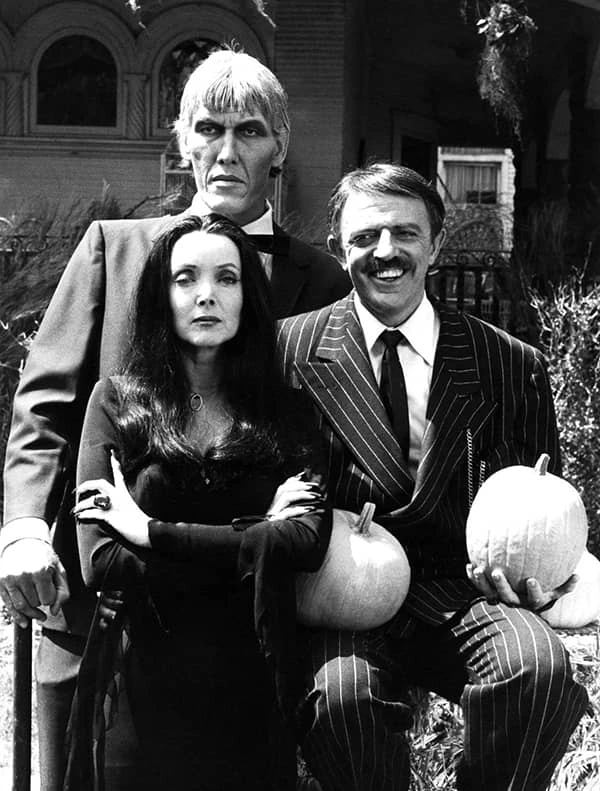
7. Fly international
Here’s a super easy idea. Dress up each member of your group as a different country, region or continent. France can don a beret and carry a baguette, while Canada can hold a cup of Tim Horton’s and talk incessantly about hockey. Just remember: cultural appreciation is awesome, while appropriation is not.

Photo credit: DaPuglet
8. The inside joke
This one is more of a prompt, but we believe in your ability to give it life. Just think of an office-wide joke and turn it into a costume. For example, we’re a web-based software company, so we have lots of inside jokes about hardware and software. Perhaps this year, an enterprising trio will dress up as a slow-moving, spammy-looking Internet Explorer, a preppy Safari, and a Chrome that seems normal but rifles through your desk for personal information as soon as your back is turned. (We still love you, Chrome.)
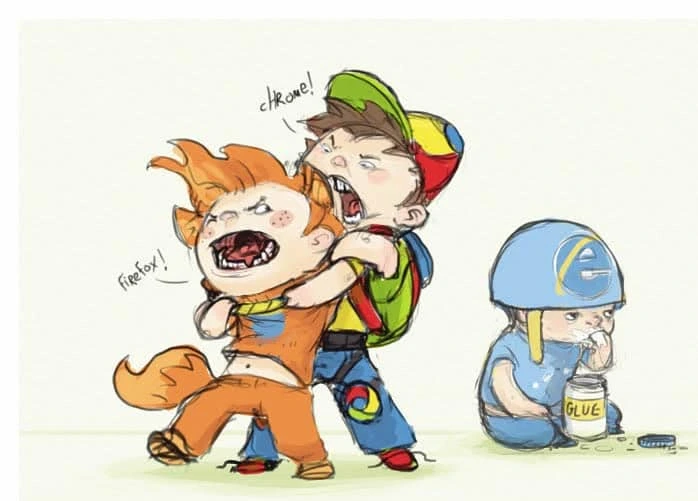
9. A star is re-born
Try dressing each member of your group as a different version of a famous actor like Tom Cruise. Aviators and a leather jacket turn you into Maverick from Top Gun, and it’s easy to create similarly recognizable costumes for his roles in Mission Impossible, Risky Business, The Outsiders, or Interview with the Vampire. You can even recreate couch-jumping Tom with a simple black turtleneck. Adapt this idea for a group of women with a prolific actor like Kate Winslet.

Photo credit: Alan Light
10. All in the family
Try dressing up as members of another department in your company. It’s even better if your departments have an ongoing rivalry.
11. Three blind mice
Why not show up as a motley crew of nursery rhyme characters? It’s certainly different from most group costumes. Plus, there are hundreds of characters to choose from: Peter the pumpkin eater, Miss Muffet and her spider friend, Little Jack Horner, Mary quite contrary, Little Bo Peep, the list goes on.

Photo credit: Wikimedia Commons
12. Where’s the beef?
We love this costume idea because it appeals to all generations. Just choose a famous ad campaign and embody it with your costume. A few ideas: The GEICO cavemen, Mac vs PC guys, the Nike swoosh, the Old Spice man, Flo from Progressive, and of course, Wendy’s “Where’s the beef?” lady.
13. Rejected Halloween candy
Want to recapture that familiar feeling of childhood disappointment? Dress your group as the least-loved leftovers of a Halloween candy stash. You’ve probably got your own list, but here are a few ideas from our team: pencils, toothbrushes, Smarties, Tootsie Rolls, candy corn, Bit O’Honey, Mary Janes, Good & Plenty, and dental floss.

Photo credit: Jamal Fanaian
We hope you enjoyed this list! Share your best group Halloween costume ideas in the comments (if you dare), and Happy Halloween.
Did you know that, every day, nearly 145 billion emails are exchanged? And what’s more mind-blowing is that 84% of these emails end up in a spam folder. To me, this makes it obvious that many people fail to understand how to send effective email messages.
You might think nobody even notices an email signature, but I’m here to tell you otherwise.
It’s more than just a decoration; an email signature communicates your identity to someone you want to build a professional relationship with but who might know nothing about you.
Related: Advertising do’s and don’ts for beginners
Let’s go over 7 do’s and don’ts that’ll help you send better emails to coworkers, customers and leads.
1. Do find a good layout (for mobile, too)
This is the first and most important step for creating an impressive email. A good email signature should be informative and neat.
What information to include will depend on the brand you’re promoting. Remember that everyone is a fan of simplicity, so keep all information to-the-point.
Everyone has smartphones these days, and the number of people opening emails with their phones is on the rise. Did you know that 48% of the emails delivered every day are opened on phones? That’s something to take note of.
Pay attention to the scale of your design. For smaller screens, you need to optimize the sizes of logos & images, and shorten any long website links & email addresses. If you’re going to use a wide logo, make sure to use a vertical template.
Use dividers to keep the signature organized and maintain a strong hierarchy. Full-bleed dividers will highlight your name and contact info—the most important info in your signature.
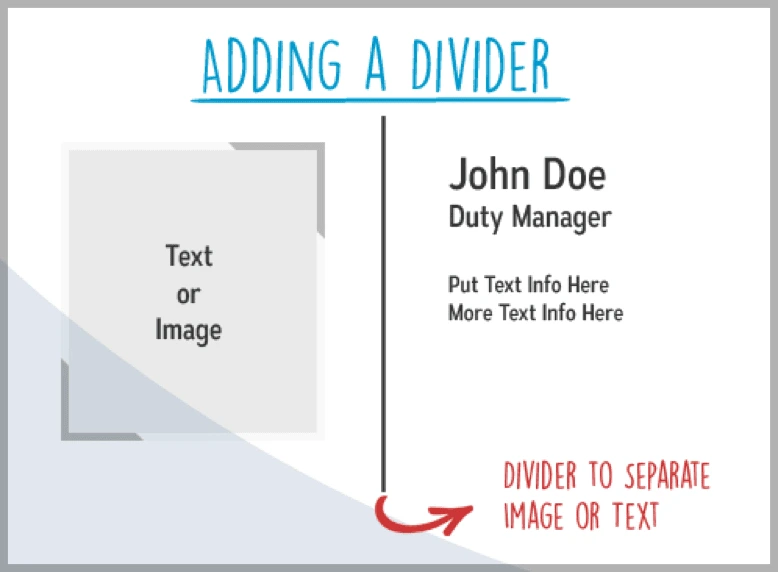
2. Don’t clutter with too much information
There is no point in using an email signature to share your autobiography. If you overstuff your signature with truckloads of links and information, it will be a turn-off for your potential clients. Plus, the chances of anyone opening the never-ending list of URLs are nil.
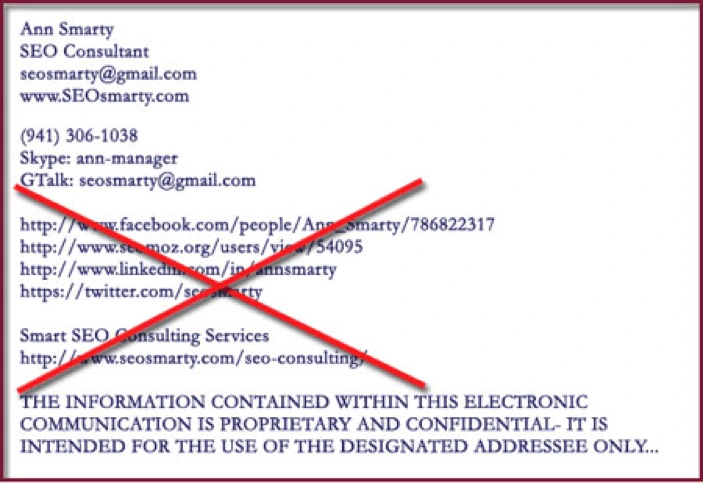
3. Do include blog & social media buttons
Digital marketing is all about making your presence felt on the web, and social media has leveled the playing ground for everyone. If you and your brand have no presence on social media, people are less likely to trust you. That’s modern psychology.
Adding Twitter, Facebook & LinkedIn to your signature will help you generate more traffic, and most importantly, your brand will get noticed.
Including your blogs, podcasts, and webinars in your signature is another clever marketing move. If you keep adding fresh content to your blog and hyperlink it in your emails, the recipients will get easy access to new content and will keep coming back for more.
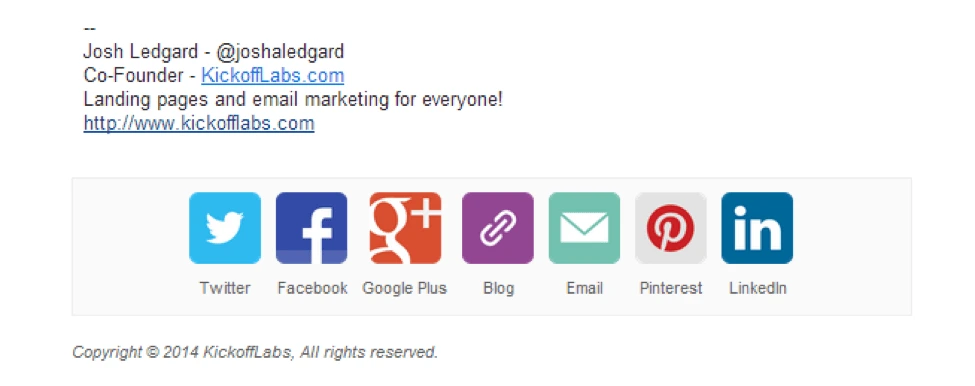
4. Don’t use multiple fonts & colors
Minimalism is in right now. Treat your email signature like a signature, not a medium to show off your graphic design skills.
To avoid making the design overly complicated, limit the number of colors and use just one type of font.
A pro tip is to take inspiration from the colors in your logo. This will help your audience recognize your brand more easily, as we know consistency is key.
Using the same font in both the email and the signature gives it a nice touch of consistency. Choose a font face and size that’s easy to read (e.g. Arial, Calibri, Tahoma, Verdana, Gill Sans, and a few others).
Using different fonts to highlight different texts makes your email signature look like an amateur school project. If you want to get a flexible typeface that can be customized according to your liking, the internet has a plethora of options for you.
5. Don’t use personal quotes
If you’re promoting a professional brand, you must leave the right impression on email recipients. The best way to do this is to only include information related to the brand. Using personal quotes, unless you are a well-recognized celebrity, would appear over-the-top and tacky.
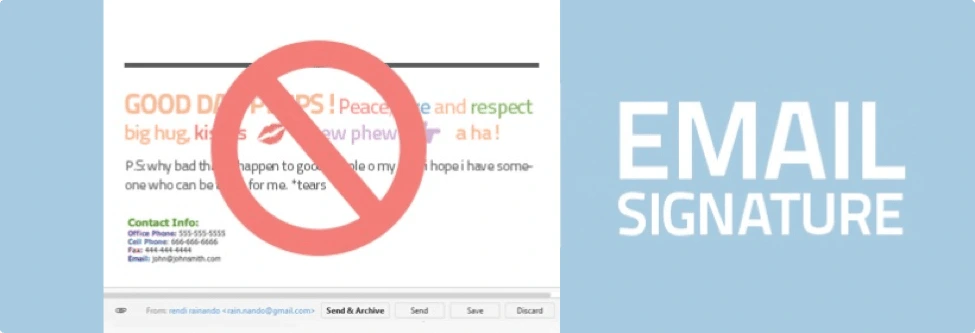
6. Don’t add long disclaimers
Including a long disclaimer in your email signature is a common mistake. Now, you might argue that it’s better to be safe than sorry. Well, I’m afraid I’ll have to pop that bubble. No legal advisor would ever tell you that email disclaimers hold any weight. Its function is strictly limited to annoying people.
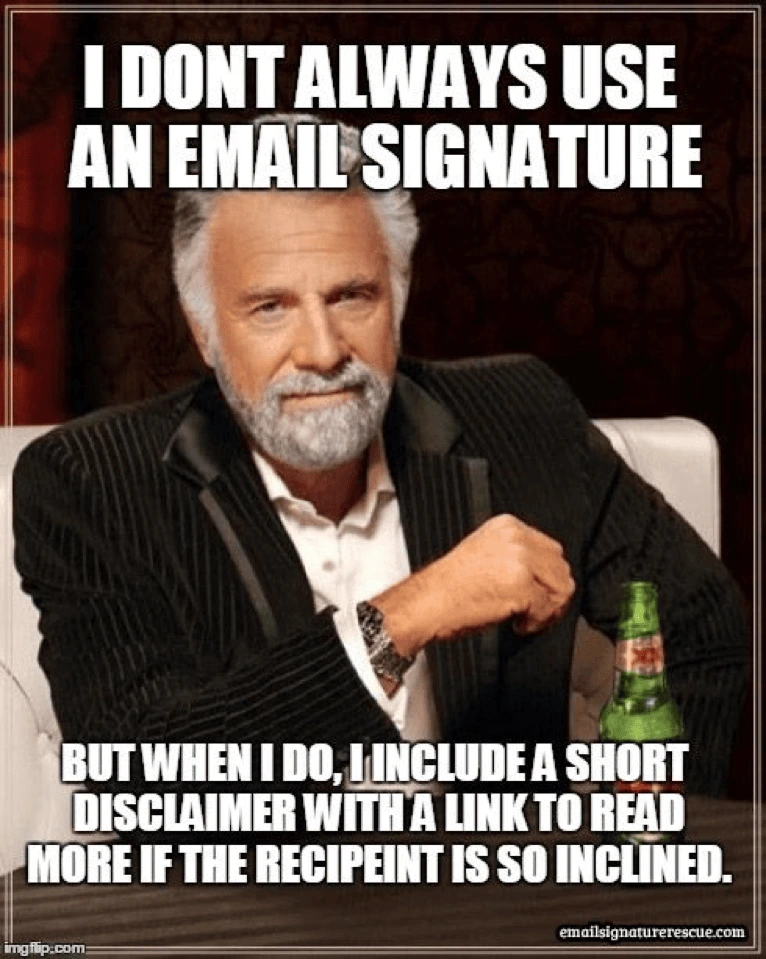
7. Do use a professional headshot
Using a headshot instead of a selfie is another tip for leaving a lasting impact. Try to look professional in the photo: dress formally, keep your hair well-groomed, look directly at the camera, and pose against a neutral background.
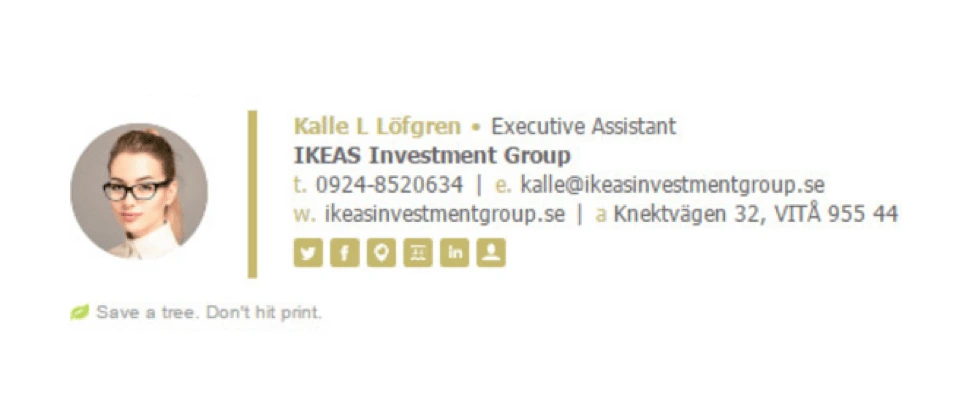
With these tips, you should feel prepared to create a strong email signature that communicates your brand as well as your own professionalism. Update your email signature and start leaving a better impression today.
Gaming is a big part of Lucidpress’s product & engineering culture. Strategic, long-term planning… tactical attacks and counter-attacks… working together to save the world from a pandemic… What’s not to love? The biggest challenge is figuring out how to play board games and still get all our work done. Here are a few things we’ve learned about playing (and working) hard as a team.
Related: How to lock in your team’s productivity
Async FTW
Everyone has variable schedules, so we’ve found that playing asynchronously over several days (maybe even weeks) makes it easier to fit with busy schedules. It also eliminates the painful effects of analysis paralysis. No more waiting for players’ min-maxing, spreadsheet-drafting minds to formulate that winning move; they can crunch the numbers without wasting other players’ time.
Here are some tips to keep in mind if you’d like to try out asynchronous gaming in the office:
- Pick board games with longer turns that aren’t dependent on other players. Examples: Terra Mystica, Caverna
- Shorter-turn games are probably more difficult and disruptive to play asynchronously in the office.
- In some cases, it might be better to have multiple short, synchronous sessions across several days or weeks instead of an asynchronous session. Examples: Ethnos, Ticket to Ride and Carcassonne
- Have a stuffed animal or other object as a turn marker. Put it on the desk of the person whose turn is next.
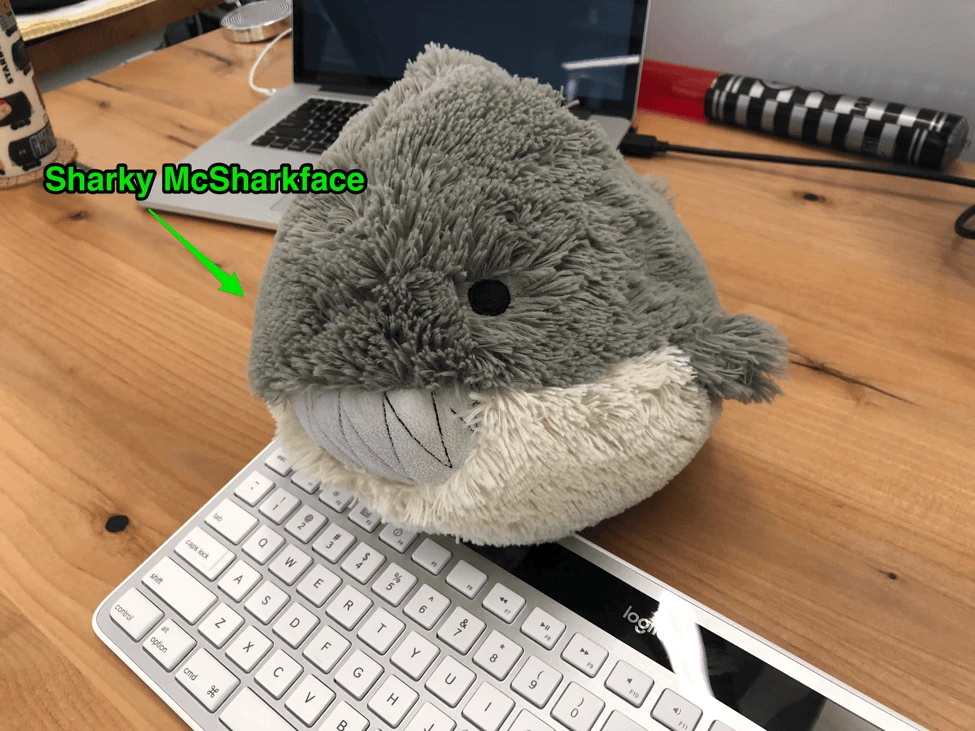
Sharky, one of our beloved turn markers
Celebrate winning (and losing)
We have traveling trophies for winners and losers in our competitive games. Bragging rights = great. Bragging rights + battle axe = amazing. On the losing side, our “Make Software Great Again” cap provides more than enough motivation—everyone fights not to be last. Hugely.

Motivation comes in many forms.

Another teams’ loser prize. Maybe the hat isn’t so bad, after all…
Co-op gaming goodness
By far, co-op games are the most-played games in the office. There are some good reasons for this:
- All for one… Co-op games unite the players against the game. Great for team-building.
- Flexible gameplay. If one of your teammates is too busy, you can play for them. Once they’re available, you can catch them up on your joint progress.
- Pandemic Legacy 1 & 2. Just get these games. Their immersive narrative and unique twists on the classic Pandemic mechanisms have enthralled our team.
- Other popular co-op games include Castle Panic, Orleans (co-op scenario), Escape and Secret Hitler (a social deduction game, but there is team-based cooperation going on).
Final thoughts
“Play is the highest form of research.”
Albert Einstein
“The enjoyment of problem-solving seems to be an evolved survival mechanism. People who enjoy solving problems are going to solve more problems, and probably get better at solving problems, and be more likely to survive.”
Jesse Schell, The Art of Game Design: A Book of Lenses
“The creation of something new is not accomplished by the intellect but by the play instinct.”
Carl Jung
Further reading:
- 6 great board games for team-building
- Why team-building is the most important investment you’ll make
- Need for recreational activities for employees, especially in the startup sector
BONUS: Creating a board game in Lucidpress
Did you know you can design your very own game boards in Lucidpress? Imagine how delighted we were to receive this tweet last year:

Source: Twitter
This innovative teacher led his classes of 4th and 5th graders to brainstorm and create their own board game, from concept to rules of play. You can see evidence of their awesome teamwork in this post describing the creation process.
If you want to design your own game board, we recommend starting with a poster-sized canvas. From there, you can pull in shapes and text boxes to create the ultimate custom game board.
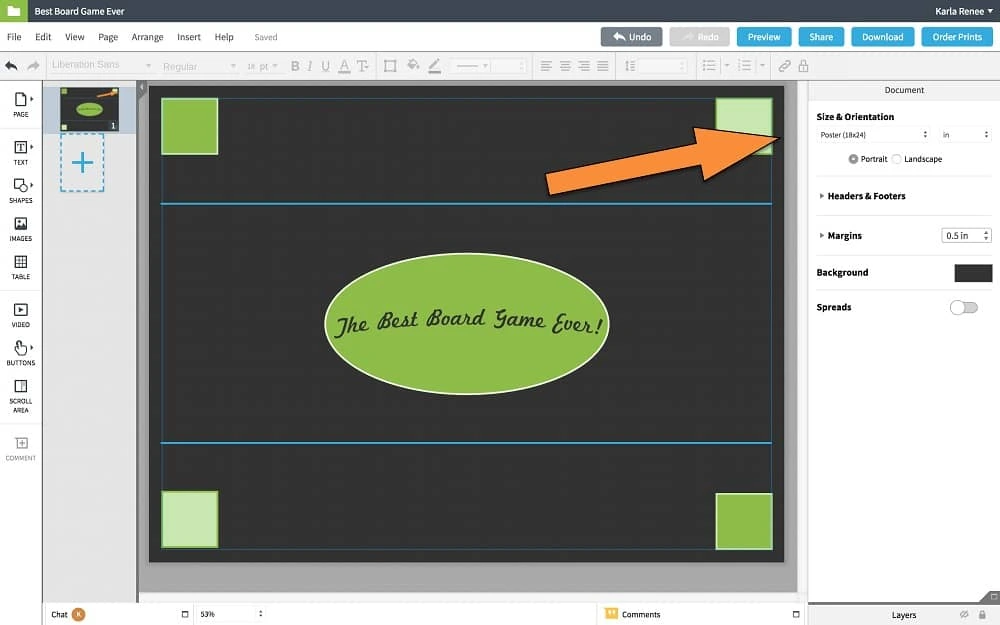
Here we’ve thrown together the humble beginnings of a game board, with an arrow pointing to the document size option.
There’s no limit to what you can create. Once you’re done, you can download your board in high-resolution, print-ready file formats (such as PDF). Or, to make it even easier, you can order printed versions directly from the Lucidpress editor. It’ll look great printed on our 18″ x 24″ glossy EPSON photo paper, and it’ll only cost you a few bucks.
Want to design your own board game? Jump into Lucidpress and play around with shapes, lines, colors, fonts & more.
In its simplest terms, employee engagement is the emotional commitment an employee has to the organization and its goals. Unlike employee satisfaction, employee engagement measures how much employees care about their work and their company.
Employee satisfaction is often connected to benefits, pay or job security. On the other hand, employee engagement relates to a manager’s influence and the employee experience through things like recognition, job assignments, trust and day-to-day communications.
For engaged employees, it’s not about the paycheck or climbing the corporate ladder. Engaged employees are the kind of folks who go above and beyond their daily workload — without being asked — simply because they care about the business or their team’s success.
But, you don’t have to take our word for it. Check out the employee engagement statistics we’ve aggregated to help you better understand how and why your company should nurture employee engagement.
Why employee engagement matters
This new focus on employee engagement isn’t for nothing — employee engagement leads to better business outcomes. Unfortunately, just 33% of American workers feel engaged in their current jobs. In fact, 52% say they’re “just showing up” and 17% describe themselves as “actively disengaged.”
With disengaged employees, you have people working for you who are doing just the bare minimum — they feel no real connection to their job. This can manifest itself as:
- An unwillingness to participate in social events outside of the office
- A tendency to fox hole oneself apart from peers
- A 9-to-5 mentality
- A negative attitude toward their job
- Low morale at a team or individual level
On the flip side, engaged employees look at the whole of their organization and understand their purpose — where and how they fit into the grand scheme of things. This can lead to more robust strategies and clearer decision-making, allowing a company to outperform the competition.
According to research from Towers Perrin, companies with engaged workers have 6% higher net profit margins. Additionally, Kenexa’s research shows that companies replete with engaged employees have five times higher shareholder returns over five years. Not only does employee engagement have the potential to affect stakeholder value and net profits, but it is also a critical factor in employee retention, productivity and loyalty.
Plus, current employee engagement helps employers attract and retain top talent. For example, employees want a good, compelling reason to stay. If they don’t have one, they’ll leave and find another company that offers them what they want. And they’re pretty certain that they can find another job. According to research by Glassdoor, 53% of employees are confident in the fact that if they were to quit or lose their current job, they could find a comparable position within six months.
By not committing to creating a fleet of engaged employees, companies rack up a considerable cost for hiring and training new hires.
Employee engagement statistics
Of course, it’s not just qualitative facts that show the impact and improvements that employee engagement brings to organizations. The following employee engagement statistics reveal the immense need to make engagement a strategic priority for your organization.
1. Organizations with an engaged workforce are 21% more profitable
Including employee engagement as part of your business strategy could help your company beat out the competition. In Gallup’s State of the American Workforce, analytics showed that businesses with the highest employee engagement scores suggested 21% higher levels of profitability compared to those in the lowest quartile. Successful engagement can come about by ensuring all employees have the best tools and knowledge available to perform their duties as well as possible.
2. 37% of employees consider recognition important
A study by O.C. Tanner asked participants a simple, but complex question — what is the most important thing a company or manager could do to help employees be successful? Out of the total survey constituents, 37% cited that recognition is the most crucial method of support. Other solutions, while helpful, lagged notably behind:
- 12% wanted more inspiration
- 12% more autonomy
- 7% more pay
- 6% more training
- 4% promotion
In short, these statistics suggest that over a third of a workplace needs, first and foremost, to be recognized.
3. Highly engaged business units achieve a 10% increase in customer ratings
Reports show that engaged business units can achieve a 20% increase in sales. Along with an increase in profitability, business units with engaged employees can achieve a 10% increase in customer ratings — meaning the employee experience has a definitive impact on the customer experience. Employees who build strong relationships with customers and are notably engaged with their job help their company increase profitability and sales.
Related: Stats that prove the value of customer experience
4. Businesses with engaged employees have 24% less turnover
It’s no surprise that the employee experience is considered valuable — companies with highly engaged employees experience 24% less turnover. Plus, 85% of HR leaders say employee experience is the most valuable HR capability. But, while workers are certainly deemed an essential aspect of business success, a recent survey reported that despite a high value being placed on employee engagement, only 24% (of survey constituents) plan on prioritizing or improving the employee experience.
5. Engaged employees are happy and healthy employees
More than 60% of engaged employees feel their work positively affects their physical health. Employee engagement statistics often highlight the effect that the workplace can have on its employees’ physical health. Wellness programs can help prevent burnout, stress and the feeling of being overwhelmed. By providing employees with the resources they need to be successful, employees are less likely to get sick and experience burnout or stress-related ailments.
6. Businesses see 70% fewer safety incidents
Engaged employees are more connected to their workplaces — and more connected employees are more aware of their surroundings. Research shows that 70% fewer safety incidents occur in workplaces with highly engaged employees. Instead of worrying about whether there’s room for advancement or whether their boss likes them, engaged employees can focus on the task at hand which reduces errant accidents.
7. About 80% of employees are considering leaving their jobs
Regardless of whether or not your employees are actively looking for a new job, a recent study found that 81% of employees would consider leaving their jobs for the “right” offer. For many, changing jobs isn’t just about money. A large percentage — 71% —of workers would iterated that they would accept a pay cut to work at their ideal job. Incentivizing employees to stay goes beyond the paycheck. Giving employees the resources and tools they need to stay engaged is one way to ensure retention. However, there also needs to be a healthy balance between the workplace and employees’ personal lives.
8. Low employee engagement costs companies up to $550 billion each year
Unengaged workers take less responsibility and ownership of their behavior and can really drain overall productivity. To offset this, companies can implement invest in cost-effective programs and tools that monitor and maintain personal engagement. In the long run, focusing on self agency and employee recognition goes a long way in boosting morale and saving companies financially.
9. Employees who feel their voice is heard are 4.6 times more likely to feel empowered to perform their best work
When creating a diverse and inclusive workplace, it’s critical to truly hear your employees’ voices. A report from Salesforce found that diverse companies that hear out their employees see a major boost in financial performance. Therefore, by inviting more people to the table, eliminating bias and establishing a diverse and inclusive community, companies can get a leg up against their competition.
10. Nearly 90% of workers at companies with well-being initiatives are more likely to recommend their company as a good place to work
According to a report published by the American Psychological Association, a determining factor in the success of wellness programs is the involvement and commitment of senior leadership. At a business where employees view leadership as uncommitted to their well-being, barely 17% of employees would recommend their respective employer as a good place to work. It goes to show that when your own employees aren’t speaking highly about a business, you lose out on great talent.
To sum up . . .
With many more statistics that prove the value of employee engagement, it’s easy to see why more companies are beginning to invest in programs to increase employee engagement. Harvard Business Review even states that engaged organizations have double the success rate compared to less engaged organizations. It doesn’t matter what industry you’re in, investing in well-rounded, all-inclusive employee engagement tactics spells out true financial success for your company.